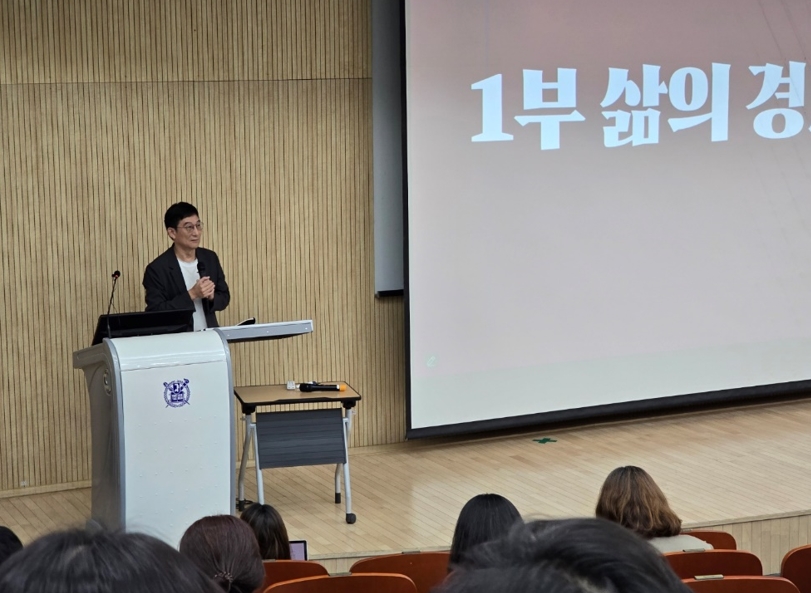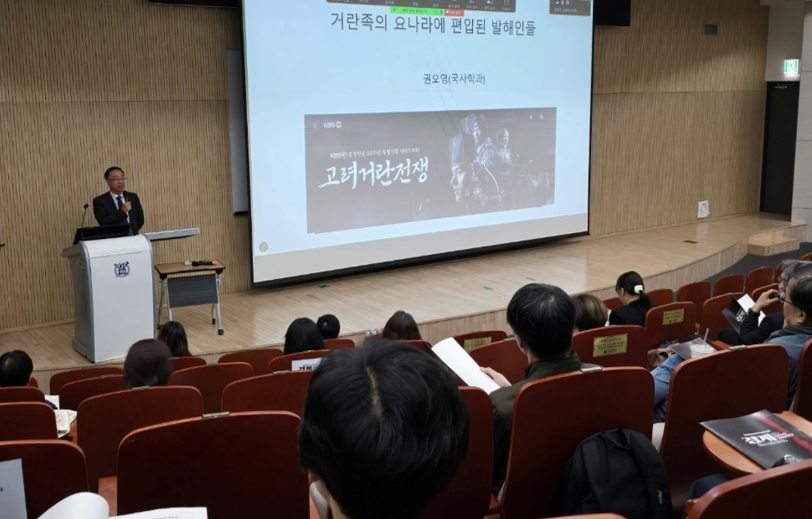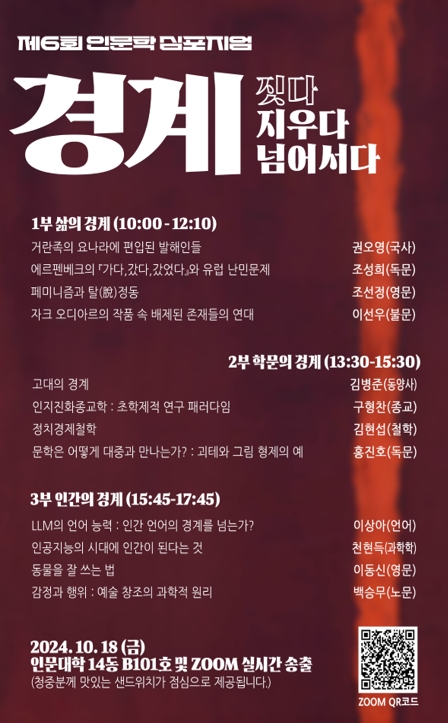Every year, Seoul National University's College of Humanities hosts a symposium that provides scholars with a platform to share their insights on universal themes. The themes for the symposium change each year, and they have previously included "Humanity," "University," "Culture," "Aging," and "Desire."
On October 18, the college held its sixth symposium to date, titled Boundaries: To Build, Erase, and Transcend. This year’s event was structured into three sessions, tackling the boundaries of life, academic study, and human existence respectively. 12 scholars delivered succinct presentations on their areas of expertise within this overarching theme, while students actively engaged with the wide range of thought-provoking ideas introduced.


Large Language Models and the Production of Human Language
In this current age, linguistic scholars have shown a vested interest in the development of Large Language Models (LLMs), particularly as those like ChatGPT have entered mainstream usage. Reflecting this growing interest, Professor Lee Sangah (Department of Linguistics) delivered a presentation titled “The Language Abilities of LLMs: Do They Transcend the Bounds of Human Language?” She delved into the capabilities and limitations of GPT-4, exploring whether or not its output is truly similar to the natural production of human language.
Professor Lee began by acknowledging the remarkable sophistication of GPT-4, citing its ability to surpass human performance on standardized tests such as the Multistate Bar Exam. She also noted GPT-4’s impressive performance in the Moral Turing Test, where its answers to ethical dilemmas displayed a logical complexity and thoroughness that exceeded those of human participants.
The mechanistic pattern-learning process that powers GPT-4’s strengths, however, is also the source of its weaknesses. Professor Lee emphasized that, unlike humans, LLMs cannot generate outputs based on a true understanding of knowledge and the communicative intentions of language. In other words, they are “stochastic parrots.” Hence, when cultural context and communicative nuance are required, GPT-4’s limitations become most apparent, sometimes going as far as to produce baseless misinformation.
Although the current outputs of LLMs cannot fully replicate the nuances of natural human language, Professor Lee is nonetheless optimistic that the ongoing advancements in artificial intelligence will continue to narrow this gap. Just this year, she published a paper on LLMs and human-like abstract thinking patterns, and there will surely be more to be uncovered on the “language” of LLMs from a linguistic perspective.
“Existential Risk” in the Age of Artificial Intelligence
Taking a different angle on artificial intelligence, Professor Cheon Hyundeuk (Department of Science Studies) presented “What it Means to Be Human in the Age of AI: What is ‘Existential Risk?’” Professor Cheon outlined the three forms of existential risk in a world of artificial intelligence: the destruction of humanity and its future by intelligent machines, disorder arising from an existential crisis of human identity and purpose, and the extinction of human uniqueness. Of the three, he recognized the third as a legitimate threat: the foundations that have made humanity the most dominant species on Earth may be irreparably eroded by an algorithmic society.
The probable harm to the fundamentals of humanity’s success is outlined as follows. Professor Cheon asserted that the increasing sophistication and ubiquity of artificial intelligence in our lives may disrupt the information ecosystem, as the costs of verifying the validity of information rise while the costs of creating disinformation plummet. Moreover, the overreliance on technology for social interaction risks greater societal polarization and fragmentation. Additionally, it may also lead to the deterioration of individuals’ problem-solving abilities. Last but not least, people’s power of imagination may be impaired, as they become accustomed to referencing the past without looking toward a future of unrealized possibilities.
By considering the likely impacts of AI development on people’s humanity, Professor Cheon urges everyone to think critically about the following: What kind of artificial intelligence is being created by technology, the capital that drives technological development, the socio-economic system in place, and our cultural practices? What impact will this have on the preservation and meaning of human existence?
Reconsidering the Line Drawn Between Humans and Animals
Taking a turn from the intersection of the humanities and artificial intelligence, Professor Yi Dongshin (Department of English Language and Literature) dove into a presentation titled “The Apt Use of Animals.”
For millennia, humans have distinguished themselves from other animals, asserting that certain inherent qualities create a natural divide between the two groups. Professor Yi, however, argued that this rigid boundary is not at all natural or innate, but rather a construct used to justify and legitimize the exploitation of animal labor. Throughout history, humans have heavily relied on animals for transportation and sustenance, with animal experimentation also expanding alongside advancements in medicine and technology. In the arts and culture, animals have been woven into narratives—mythology, fables, and children’s bedtime stories—across all forms of media.
Up until now, however, there has been little consideration for these creatures beyond the limitations of a strictly anthropocentric viewpoint. The irony lies in the fact that animals have been brought so intimately into the human realm due to the similarities that they share with us, in their physicality and emotionality.
Professor Yi thus concluded his talk by emphasizing the value of a posthumanist perspective on the humanities and the world. Citing Cary Wolfe, a prominent scholar in posthumanism, he asserted that the exclusion of animals from the category of entities with inherent and legally protected rights is in itself a form of violence.

Throughout Boundaries: To Build, Erase, and Transcend, attendees sampled an extraordinary range of topics, discovering how a single theme may be interpreted in so many ways by scholars from different specializations. It was truly a day to remember and one that leaves us pondering what next year’s theme may be.
Written by Hee Seo Lee, SNU English Editor, heeseolee@snu.ac.kr

